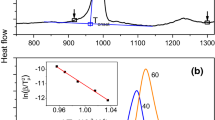Abstract
A model has been devised to derive the intermetallic structure from the bcc- Fe unit cell. The fundamental finding is of special interest because the recent investigation clarifies that there is substantial evidence that atomic arrangements of transition metal-rich amorphous alloys are made of distorted bcc structure. The disordered bcc structure is thermodynamically in a metastable state, the heat treatment leads by crystallization of amorphous alloys to a stable state. In the past, a great deal has been made to describe the process of crystallization of amorphous alloys, but unfortunately, the disordered bcc-Fe regions of amorphous alloys have been neglected. Since the crystallization process takes place from the disordered bcc-regions of amorphous state, it is advisable to reexamine, discuss, and, where necessary to modify the product of the crystallization by the experimental achievements. It is therefore the objective of the present investigation to devise a model based on experimental facts. The atomic size of metalloid atoms determines the crystallization and crystal growth of amorphous alloy. Regardless of their structure, Mössbauer investigation on Fe-rich Metal-Metalloid alloys indicates that the metalloid atoms such as B, P, C, and Ge tend to act with iron by spending their electrons into the Fe 3d-band.












Similar content being viewed by others
References
C. S. Barrett and T.B. Massalski, Structure of Metals, Pergamon Press Oxford, (1980) p. 230.
Nguyen, M.C., Zhao, X., Ji, M., Wang, C.Z., Harmon, B., Ho, K.M.: J. Appl Phys 111, 07E338 (2012). https://doi.org/10.1063/1.3677929
Pan, S.P., Feng, S.D., Qiao, J.W., Wang, W.M., Qin, J.Y.: Sci. Rep. 5, 16956 (2015). https://doi.org/10.1038/srep16956/
Ghafari, M., Gleiter, H., Feng, T., Ohara, K., Hahn, H.: J. Mate. Sci. Eng. 5, 299 (2016). https://doi.org/10.4172/2169-0022.1000299
R. Witte, T. Feng, J. X. Fang, A. Fischer, M. Ghafari, R. Kruk, R. A. Brand, D. Wang, H. Hahn and H. Gleiter, Appl. Phys. Lett. 103 (2013) 073106–1. http://apl.aip.org/resource/1/APPLAB/v103/i7
Ghafari, M., Louzguine-Luzgin, D.V., Hutchison, W.D., Feng, T., Campbell, S.J.: J. Phys.: Condens. Matter 30, 455701 (2018). https://doi.org/10.1088/1361-648x/aae505
F. E. Luborski, Amorphous Metallic Alloys, Butterworths (1983) pp. 3–90. ISBN 0408110309.
Takács, L.: Phys. Stat. Sol. (a) 56, 371 (1979). https://doi.org/10.1002/pssa.2210560142
Vincze, I., Cadeville, M.C., Jesser, R., Takács, L.: J. Phys. 35, C6-533 (1974). https://doi.org/10.1051/jphyscol:19746113
R. A, Brand, Mössbauer Fit Programs, Distributed by: WissEl Company GmbH, 2006, Germany
Cooper, J.D., Gibb, T.C., Greenwood, N.N., Parish, R.V.: Trans. Faraday Soc. 60, 2097 (1964). https://doi.org/10.1039/TF9646002097
Weisman, I.D., Swartzendruber, L.T., Bennet, L.H.: Phys. Rev. 177, 465 (1969). https://doi.org/10.1103/PhysRev.177.465
Rundqvist, S.: Arkiv Kemi 16, 1 (1962). https://doi.org/10.3891/acta.chem.scand.16-0001
Kiessling, R.: Act Chem. Scand 4, 209 (1950). https://doi.org/10.3891/acta.chem.scand.04-0209
W. K. Choo, and R. Kaplow, Met., Trans. 8A (1977) 417. https://doi.org/10.1007/BF02661750
C. E. Housecroft and A. G. Sharpe, Inorganic Chemistry(2nd ed.). Pearson Prentice-Hal. (2005) p. 100. ISBN 0130–39913–2.
Pauling, L.: J. Am. Chem. Soc. 53(4), 1367 (1930). https://doi.org/10.1021/ja01355a027
Brittin, W.E.: J. Chem. Educ. 22(3), 145 (1945). https://doi.org/10.1021/ed022p145
Pauling, L.: The Nature of the Chemical Bond (3rd ed.), pp. 111–120. Oxford University Press (1960).
Clayden, J., Greeves, N., Warren, S., Wothers, P.: Organic Chemistry (1st ed.). (2001) p. 105. Oxford University Press. ISBN 978–0–19–850346–0.
Schwarz, K., Mohn, P., Blaha, P., Kübler, J.: J. Phys. F: Met. Phys. 14, 2659 (1984). https://doi.org/10.1088/0305-4608/14/11/021
Ghafari, M., Hahn, H., Gleiter, H., Sakurai, Y., Itou, M., Kamali, S.: Appl. Phys. Lett. 101, 243104 (2012). https://doi.org/10.1063/1.4769816
Ghafari, M., Hahn, H., Feng, T., Kruk, R., Yan, M.: Hyperfine Interact 242, 2 (2021). https://doi.org/10.1007/s10751-021-01725-7
Jauch, W., Reehuis, M.: Phys. Rev. B 76, 235121 (2007). https://doi.org/10.1103/PhysRevB.76.235121
Novák, P., Chlan, V.: Phys. Rev. B 81, 174412–174421 (2010). https://doi.org/10.1103/PhysRevB.81.174412
Freeman, A.J., Watson, R.E.: Phys. Rev. Let. 5(11), 498 (1960). https://doi.org/10.1103/PhysRevLett.5.498
Kittel, C.: Introduction to Solid State Physics (2005), -8th ed-. John Wiley & Sons, Inc., ISBN 978–0–471–41526–8
Neese, F.: Inorg. Chim. Acta 337, 181 (2002). https://doi.org/10.1016/S0020-1693(02)01031-9
Jeffries, J.E., Hershkowitz, N.: Phys. Lett. 30A, 187 (1969). https://doi.org/10.1016/0375-9601(69)90927-X
Murphy, K.A., Hershkowitz, N.: Phys. Rev. B 7, 23 (1960). https://doi.org/10.1103/PhysRevB.7.23
Dubiel, S.M.: J. Alloys Compd. 488, 18 (2009). https://doi.org/10.1016/J.JALLCOM.2009.08.101
Persson, K.: Materials Data on Fe2B (SG:123) by Materials Project (2016) p. 2020. https://materialsproject.org/docs/calculations. https://doi.org/10.17188/1274675
Persson, K.: Materials Data on Ti3P (SG:86) by Materials Project. (2016). https://materialsproject.org/docs/calculations. https://doi.org/10.17188/1205511
Bernas, H., Campbell, I.A., Fruchart, R.F.: J. Phys. Chem. Sol. 28, 17 (1967). https://doi.org/10.1016/0022-3697(67)90192-8
Author information
Authors and Affiliations
Corresponding author
Additional information
Publisher’s note
Springer Nature remains neutral with regard to jurisdictional claims in published maps and institutional affiliations.
This article is part of the Topical Collection on Proceedings of the International Conference on Hyperfine Interactions (HYPERFINE 2021), 5-10 September 2021, Brasov, Romania
Edited by Ovidiu Crisan
Rights and permissions
About this article
Cite this article
Ghafari, M., Feng, T. Body-centered-cubic structure as a basis for deriving the intermetallic crystal structures. Hyperfine Interact 243, 21 (2022). https://doi.org/10.1007/s10751-022-01804-3
Accepted:
Published:
DOI: https://doi.org/10.1007/s10751-022-01804-3




